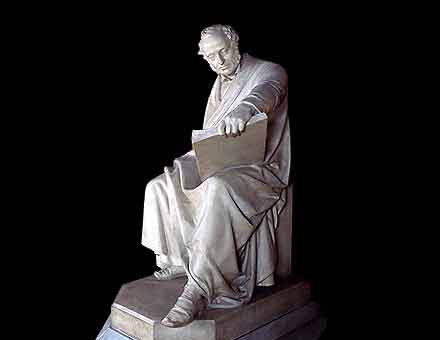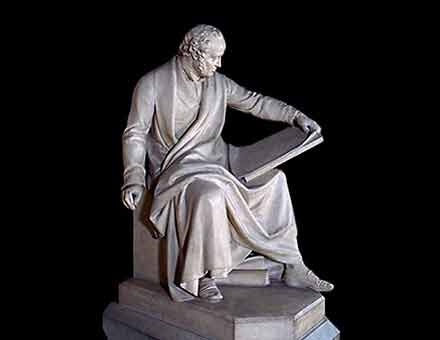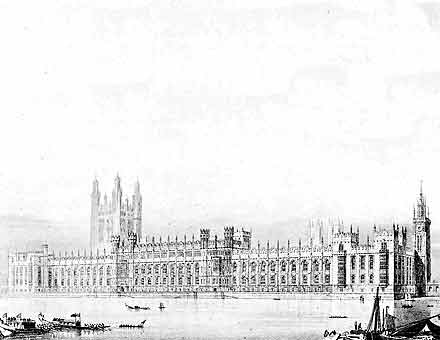Sir Charles Barry (1795-1860)
© 2007
Armchair Travel Co. Ltd. - This page may be used for non-commercial purposes
ONLY!
![]()

[ Play
Narrated and Animated Movie ! ] On the Committee Stairs is this statue of Sir Charles Barry.
The future architect of the new Palace of Westminster, was articled in youth as a surveyor in Lambeth, and after foreign travel, started practice in London in 1820. In 1835 he won the competition for the new Palace of Westminster. At a stroke he was at the age of 40 the chief architect of early Victorian England. From then until his death in 1860 he worked at this stupendous task, aided by the prolific and obsessive Gothicist A.W. Pugin. The commission brought him fame and much important work. But it was also a bed of nails: he suffered more trouble and frustration than any English architect since the days when Wren tried to design a new city of London after the Great Fire of 1666.
Barry is shown here by the sculptor J H Foley examining the groundplan of the building, and his plans for the Victoria Tower.
Barry's touch was a careful, methodical 'quill pen', giving each form its distinct value.
When the old Palace of Westminster was in conflagration in October 1834, the blaze could be seen for miles. Travellers on the Brighton coach saw it before them as they rolled towards London. One of those travellers was Charles Barry, thirty-nine years old, a rising and ambitious architect. He had at that time only one complete building in London to his name: the Travellers' Club in Pall Mall, built in 1829.
On arrival he jumped from the coach and stayed all night, watching with the crowds the terrible destruction. To him, it seemed an immense opportunity: the man who rebuilt the Palace of Westminster would win immortal fame.
Ninety-seven competitors entered the competition to design the new Palace. of the eventual short-list of five, Barry emerged the winner. But he did not have an easy time of it: throughout his career he was ridiculed and abused. The Palace of Westminster was indeed the great opportunity he had hoped: but it also ate up his life and destroyed his peace of mind.
Barry was dead by 1860: his great collaborator, Augustus Pugin, who had worn himself out in the hectic, non-stop production of drawings for the building, had died eight years earlier. Their sons waged a war in print as to which of the men was the real creator of the Houses of Parliament. But Pugin himself is known to have said to a friend: 'I could not have made that plan. It was Barry's own. He was good at such work.'
Barry was full of judgement, patient, never doing one day what might be safely delayed to the next, his mind sifting every thought, method and form; and his decision was the logical result.
[ Virtual
Tour ] [ Main Topics
Index ]
- John Hardman Powell.




Additional Information on
Sir Charles Barry (1795-1860)
QUOTATION
- John Hardman Powell.
Explore-Parliament.net: Advanced Category Search
Keyword Categories:
_Object_Sculpture
_Object_Artwork
_Object_Portrait
_Artist_Foley
_Designer
_Man
_Person
_Barry